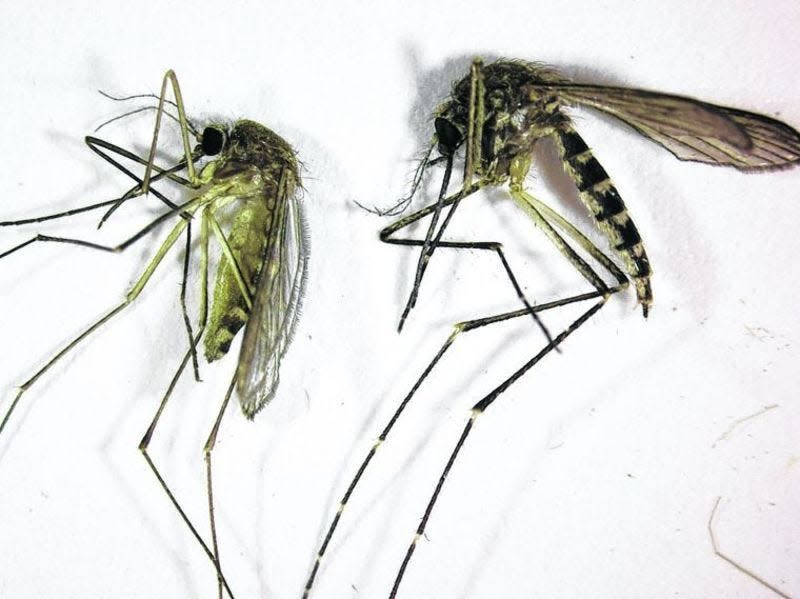Notre Dame, IU and Purdue join Midwest effort to fight mosquito and tick-borne diseases
Researchers at Purdue University, Indiana University and the University of Notre Dame are teaming up with other researchers in the Midwest to combat the spread of illnesses caused by ticks and mosquitoes.
Using funding from the Centers for Disease Control and Prevention, scientists and public health professionals from the three universities will work with their counterparts at the Midwest Center of Excellence for Vector-Borne Diseases.
The $10 million Midwest center, which was formed in 2017, is led by the University of Wisconsin-Madison, and is funded for five years by the Centers for Disease Control and Prevention.
“The new Indiana partners are fortifying the center’s capacity to advance innovative vector-control approaches for mosquito and tick threats that are unique to the Midwestern environment,” Lyric Bartholomay, professor of pathobiological sciences at University of Wisconsin-Madison and co-director of the Midwest Center, said in a release.
West Nile is already here:Now health experts are watching out for deadly EEE virus
“We’re grateful and excited to be included in this second round,” Catherine Hill, professor and interim head of Purdue’s Department of Entomology in the College of Agriculture, said in the release. “Unfortunately, mosquitoes and ticks don’t pay any attention to state borders.”
The Indiana institutions will work closely with the Indiana Department of Health. All have industry connections and expertise in vector-control product development, testing and evaluation.
New weapons
Hill’s team at Purdue, for example, is pursuing minimum-risk plant-derived products for controlling Lyme disease and tick pests.
“Ticks are a big problem,” Hill said. “And one tick, in particular — Ixodes scapularis, the Lyme disease tick — is a vector of Lyme disease and multiple other diseases in the region.”
Hill said the lone star tick and the dog tick also pose problems for Indiana, and the Asian longhorned tick, an invasive species first detected in the United States in 2017, could eventually become a threat if it spreads into Indiana from Kentucky.
“If it moves north, it could become a vector of various human-disease pathogens,” she said in the release. “But the tick also threatens livestock and other animals.”
While Purdue is focusing on developing and testing products aimed at tick control, Notre Dame and IU are studying mosquitoes, which carry West Nile virus and other diseases.
At Notre Dame, a lab run by research professors John Greico and Nicole Achee is developing spatial repellants. Unlike topical repellants for the skin, spatial repellents include hanging strips or tabletop devices that create a mosquito-free environment within a certain area.
“We’re trying to focus more on the natural products — botanicals, geranium oils and other extracts — because those are going to be much more accepted by the U.S. market,” Grieco explained in the release.
Molly Duman Scheel, a professor of medical and molecular genetics at the IU School of Medicine-South Bend, is involved in developing an insecticide that would specifically target the Culex mosquito, which carries West Nile virus.
Developing a new class of insecticides is important because mosquitoes can become resistant to pesticides. “The more you use them, the mosquitoes are going to become more resistant to them,” she said by telephone.

And developing a pesticide that targets the Culex mosquito removes concerns about killing honey bees and other beneficial insects through the use of generalized insecticides, Scheel added.
Trying to get out front
Warmer temperatures and added precipitation as a result of global warming likely means the Midwest will continue to see an increase in the number of disease-carrying insects as well as the types of diseases they are carrying, according to the scientists.
“The populations and the potential for the spread of additional diseases is growing,” Scheel said.
That’s what Brett Davis, St. Joseph County’s assistant director of environmental health, has noticed during his five years in the field. As of Friday, West Nile had been detected in six separate pools of mosquitoes in the county, and this area is typically one of the worst in the state for tick-borne Lyme Disease.
Those illnesses are bad enough, but, Davis said, he’s most concerned about the more regular appearance of Eastern Equine Encephalitis in the Michiana area.
EEE is also carried by mosquitoes, and the CDC says that approximately 30% of people with EEE die and many survivors have ongoing neurological problems.
“EEE used to show up every 10 years or so,” Davis said by phone. “Now it’s showing up nearly every year.”
The last significant outbreak of the virus occurred in 2019, That year, 10 people in Michigan ― including two in Berrien and two in Cass counties ―were infected with the virus and six people died. In Elkhart County, one person died that year.

On Friday, Michigan reported that a horse in nearby St. Joseph County died from the EEE virus. Health officials on both sides of the border have been testing for the disease in the mosquito population much of the summer.
“I welcome these universities joining the Midwest Center for Excellence,” Davis said. “New research and new tools will likely be necessary to fight the spread of these diseases moving forward.”
This article originally appeared on South Bend Tribune: ND, IU and Purdue join the battle to fight tick and mosquito diseases
